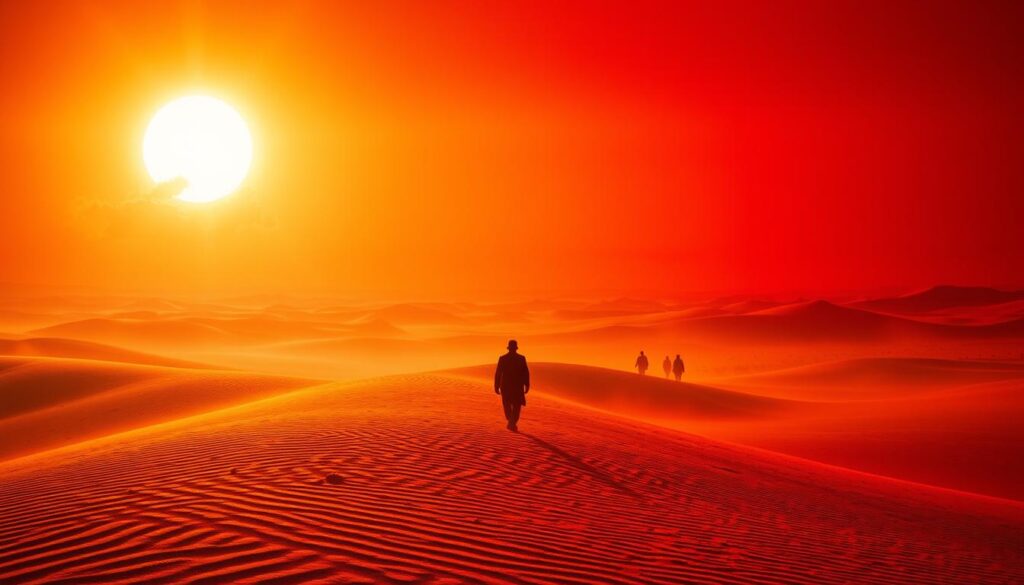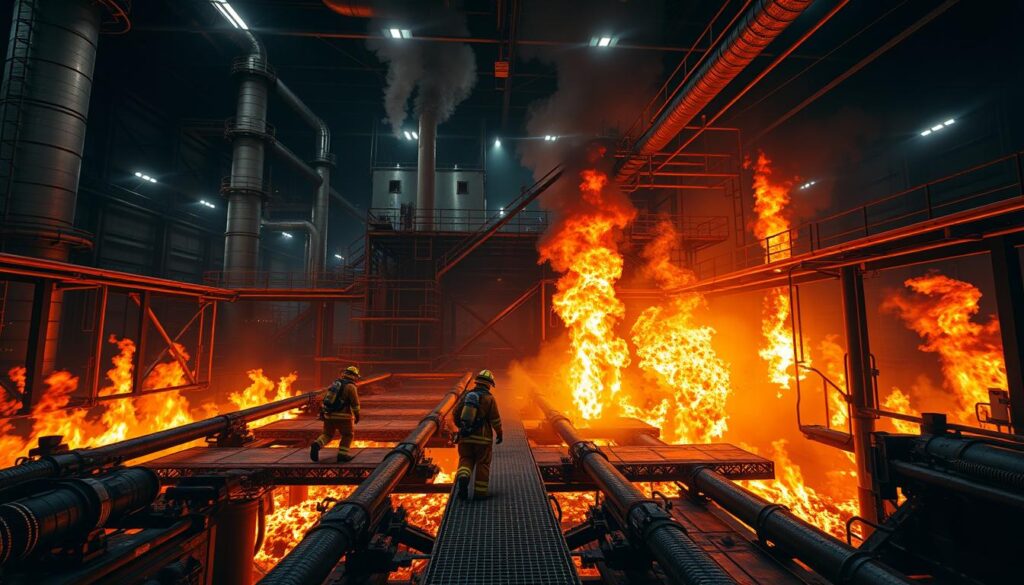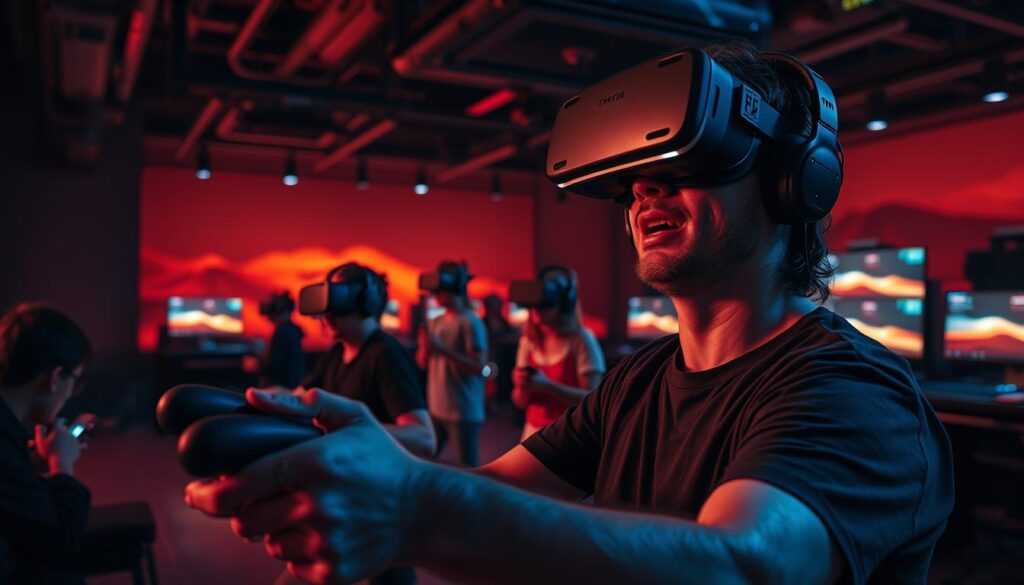Heat VR: 4 Intense Virtual Worlds That Thrill Adventurers
16 min read
Table of Contents
Can virtual reality really feel like real adventures? Heat VR lets users dive into intense virtual worlds. These worlds challenge their senses.
The growth of virtual reality technology has brought us Heat VR. It mixes virtual reality with heat simulation for a deep experience.

With four intense virtual worlds, Heat VR is perfect for those who love adventure. It changes the game in industries like gaming and training.
The Rise of Heat VR Technology
Heat VR technology is a big step forward in virtual reality. Companies like HOLOGATE and Gravity VR are leading the way. They create experiences that feel real, including temperature changes.
What Makes Heat VR Different from Standard VR
Heat VR is special because it uses advanced thermal feedback systems. These systems let users feel temperature changes. This makes virtual worlds feel more real and exciting.
Breakthrough Thermal Feedback Systems
The breakthrough thermal feedback systems in Heat VR let users feel temperature changes. This adds a new level to virtual reality. It’s key for making experiences feel like real life.
Sensory Immersion Capabilities
The sensory immersion capabilities of Heat VR are improved by simulating different temperatures. Users can feel the warmth or coolness of their surroundings. This makes the virtual world feel more real.
Understanding Heat Simulation in Virtual Reality
The science behind heat simulation in virtual reality is about how our brains react to heat. It’s key for making experiences that feel real.
The Science Behind Temperature Sensation in VR
VR uses our brain’s heat response to create temperature feelings. This process involves:
- Thermal Stimulation: It turns on the nerves that feel temperature changes.
- Neurological Interpretation: Our brain then sees these signals as heat or cold.
Neurological Response to Thermal Stimuli
The way our brain reacts to heat is vital for real feelings. The heat receptors in our skin send messages directly to the brain.
Calibration and Personalization Factors
For the best experience, systems are set up to match each user. They adjust to how each person feels and responds.
Hardware Components of Heat VR Systems
Heat VR systems use special hardware for real heat feelings. The main parts are:
- Thermal Actuators: These create heat or cold.
- Controllers: They control the heat to mimic different places.
Thermal Actuators and Controllers
Together, thermal actuators and controllers offer exact heat control. This makes VR more real.
Integration with Standard VR Headsets
Working with common VR headsets means users can enjoy heat simulation easily. They don’t need extra gear.
Heat VR: Revolutionizing Immersive Experiences
Heat VR is changing how we experience virtual worlds. It makes interactions more real and engaging. This technology is a big step up in VR.
From Concept to Commercial Reality
Heat VR went from idea to real product thanks to big investments and development milestones. These steps were key in making the tech we see today.
Investment and Development Milestones
Big investments helped Heat VR grow. They led to better heat simulation tech. This has made the virtual reality heat experience much better.
Consumer Adoption Trends
More people are using Heat VR. They see its value in entertainment and training. This shows a growing interest in heat VR applications.
Key Players in the Heat VR Market
The Heat VR market has leaders pushing innovation. They do this through strategic partnerships and collaborations. These players are shaping the future of Heat VR.
Leading Manufacturers and Developers
Top companies are making advanced Heat VR systems. Their work is essential for a better virtual reality heat experience.
Strategic Partnerships and Collaborations
Partnerships are driving innovation. They let companies share resources and knowledge. This teamwork is expected to lead to more heat VR applications.
Virtual World #1: Volcanic Expedition
In the Heat VR universe, the Volcanic Expedition is a top choice. It uses advanced heat simulation tech for an immersive adventure. This virtual world offers a realistic volcanic environment, challenging and thrilling users.
Gameplay and Heat Mechanics
The Volcanic Expedition mixes fun gameplay with complex heat mechanics. It offers a unique experience for users. The game challenges players with temperature variation and intensity levels that mimic a volcanic environment.
Temperature Variation and Intensity Levels
The game has different temperature levels, from warm to extreme heat. This simulates the conditions of an active volcano. This variation makes the experience feel real and immersive.
Challenge Progression and Objectives
As players move through the Volcanic Expedition, they face new challenges and goals. These challenges assess how well they can adapt to the virtual setting. The game’s design keeps the experience engaging and rewarding.
User Experience and Realism Factors
The Volcanic Expedition’s realism is a big part of its appeal. Early users have praised its authentic simulation of a volcanic environment. They say it’s as good as real volcanic landscapes.
Testimonials from Early Adopters
Users feel very immersed, with some saying it’s “surprisingly realistic.” These comments show how well the Heat VR tech creates a believable virtual world.
Comparison to Real Volcanic Environments
The Volcanic Expedition’s detail, from heat to visuals and sounds, adds to its realism. It’s compared well to real volcanoes. This shows how well the simulation captures the challenges and feelings of exploring volcanoes.
Virtual World #2: Desert Survival Challenge
The second virtual world in Heat VR is the Desert Survival Challenge. It tests players’ survival skills in a harsh desert. The game uses realistic heat and challenging gameplay to push players to their limits.
Environment Design and Heat Dynamics
The desert in Heat VR is designed to feel like a real desert. It has dynamic heat elements that change how you play.
Day-Night Temperature Cycles
Players face extreme temperature changes from day to night. The hot days can cause dehydration, while cold nights can lead to hypothermia.
Weather Events and Heat Waves
The desert also has unpredictable weather like sandstorms and heat waves. These make survival even harder. Players must adjust to these changes to stay alive.
Survival Mechanics and Player Strategies
To survive, players must manage resources well. They need to find ways to deal with the harsh environment.
Resource Management Under Heat Stress
Players must carefully use water and food. Dehydration is a big risk. Heat stress also affects how well they can move, so they need to rest too.
Adaptation Techniques and Equipment
Using the right survival gear is key. Finding shade, using coolers, and making protective clothes are important. Players must also change their plans as the desert changes.
Heat VR’s Desert Survival Challenge combines realistic environments with tough survival tasks. It gives players a realistic heat simulation experience. This prepares them for survival in real life.
Virtual World #3: Industrial Firefighting Simulator
The Heat VR simulator is changing how firefighters train. It gives them a real and immersive experience. This prepares them for the tough conditions they might face in emergencies.

Training Applications and Real-world Benefits
The Industrial Firefighting Simulator has big training applications. It offers real benefits for firefighters. It simulates real firefighting scenarios to improve their skills and readiness.
Professional Endorsements and Adoption
Firefighting pros endorse the simulator. They say it accurately simulates the intense heat and complex scenarios of industrial fires. So, it’s been adopted by many firefighting training programs.
Skill Transfer to Actual Emergency Situations
The simulator helps transfer skills to real emergencies. Firefighters practice in a realistic virtual setting. This builds their muscle memory and decision-making skills for real fires.
Heat Intensity Levels and Safety Features
The simulator lets you adjust heat intensity levels. This ensures training fits the firefighters’ needs. It also has safety features to protect the trainees.
Customizable Training Scenarios
The Industrial Firefighting Simulator offers customizable training scenarios. Trainers can change the difficulty and specifics to meet the firefighters’ needs.
Physiological Monitoring Systems
The simulator has physiological monitoring systems. These track the trainee’s vital signs and physical responses. This keeps training safe and provides feedback in real-time.
Virtual World #4: Tropical Jungle Adventure
In Heat VR’s Tropical Jungle Adventure, players find themselves in a lush, vibrant world. It’s full of life and heat. This virtual world is designed to challenge adventurers with its realistic climate simulations, making it an immersive heat simulation experience.
Humidity and Temperature Variations
The Tropical Jungle Adventure features dynamic humidity and temperature variations. This creates a truly immersive environment. The microclimate simulation technology used here ensures players experience a range of temperatures and humidity levels.
Players feel the sweltering heat of the day and the cooler temperatures at night.
Microclimate Simulation Technology
This technology allows for diverse microclimates within the jungle. Each has its unique temperature and humidity characteristics. To make it through, players need to adjust to the shifting conditions.
Time of Day and Weather Effects
The time of day and weather effects in Tropical Jungle Adventure significantly impact the player’s experience. For example, the heat index increases during the day, making survival more challenging. Rain can provide temporary relief from the heat.
Exploration Elements and Environmental Challenges
The Tropical Jungle Adventure is not just about surviving the heat. It’s also about exploring the environment and overcoming challenges. Players will encounter diverse wildlife and undertake survival quests, all while navigating through the dense jungle terrain.
Wildlife Encounters and Survival Quests
Players will encounter various wildlife, some friendly and others not. Survival quests require players to gather resources, craft tools, and build shelter. All while managing their body temperature and hydration levels.
Navigation and Terrain Challenges
The jungle terrain is dense and challenging to navigate. It has steep cliffs, raging rivers, and dense foliage. Players must use their wits and skills to overcome these obstacles and progress through the adventure.
The Technology Powering Heat VR Experiences
Heat VR uses advanced tech to create a unique VR experience. It combines thermal feedback, software, and safety features. This mix lets users dive into virtual worlds that feel real.
Thermal Haptic Feedback Systems
Thermal haptic feedback systems are key for Heat VR. They use wearable components to cover the body. This gives a full sensory experience.
Wearable Components and Body Coverage
The wearables are comfy and cover a lot of the body. This lets users feel heat in different places. It makes the VR feel more real.
Response Time and Temperature Range
The speed and range of these systems are important. A quick response time means heat feels immediate. A wide temperature range lets for various scenarios, from warm to hot.
Software Integration for Temperature Control
Software is key for controlling temperature in Heat VR. It uses AI-driven environmental adaptation. This means the system can change temperature based on the virtual scene.
AI-Driven Environmental Adaptation
AI-driven adaptation makes the temperature and heat feel right for each scene. It boosts realism and immersion.
Developer Tools and SDK Features
Developers have tools and SDK features to make custom Heat VR experiences. These tools help adjust temperature and create unique scenes.
Safety Protocols and Limitations
Safety is top priority in Heat VR. It has automatic shutdown thresholds and user health monitoring systems. These prevent harm to users.
Automatic Shutdown Thresholds
If there’s too much heat or a safety issue, the system shuts down. This protects the user.
User Health Monitoring Systems
User health monitoring systems keep an eye on vital signs and health indicators. This ensures a safe VR experience.
User Reactions and Health Considerations
Users diving into Heat VR experiences show us its benefits and risks. The immersive tech can cause strong physical and emotional reactions. It’s key to know both the immediate and long-term effects.
Physical and Psychological Effects
Heat VR users feel a range of sensations. They report excitement and discomfort, just like in real life. Reported sensations include a faster heart rate and sweating, mimicking real-world challenges.
Reported Sensations and Experiences
Heat VR experiences vary, with some users feeling very present and others feeling disoriented.
Long-term Usage Studies
Studies are ongoing to see how Heat VR affects us over time. They look at its impact on our physical and mental health.
Medical Applications and Therapeutic Potentials
Heat VR goes beyond fun, with big medical applications. It’s useful in pain management, exposure therapy, and rehab. It lets us practice in safe, controlled environments.
Pain Management and Exposure Therapy
Heat VR might help manage pain by distracting us. It also helps in exposure therapy by safely simulating tough environments.
Rehabilitation and Physical Therapy Uses
The tech also has promise for rehab. It lets patients do physical therapy exercises in fun, interactive ways.

Future Developments in Heat VR
The future of Heat VR is set to change the virtual reality world. We’ll see new heat experiences thanks to tech advancements. Expect big improvements in many areas.
Upcoming Virtual Worlds and Experiences
New virtual worlds and experiences are coming to Heat VR. These will include different environments. They will challenge users to adapt to various heat conditions.
Announced Titles and Release Dates
Some new titles have been announced, with release dates soon. These titles will offer even more immersive experiences.
Genre Expansion Beyond Adventure
Heat VR will move beyond adventure games. It’s set to offer fresh adventures designed for a broader crowd.
Technological Advancements on the Horizon
Heat VR’s technology is always getting better. Big advancements are coming soon.
Next-Generation Thermal Feedback
New thermal feedback systems will make temperature sensations more realistic. This will improve the VR experience.
Integration with Other Sensory Systems
Heat VR will work with other sensory systems like haptic feedback. This will make the virtual world feel even more real.
Conclusion
Heat VR has changed the virtual reality world by bringing immersive heat simulation experiences. It offers four intense virtual worlds. This makes it exciting for adventurers and adds realism to VR experiences.
The tech behind Heat VR has many uses in entertainment, training, and therapy. Heat VR games and experiences let users interact with virtual worlds in a unique way. It’s also used in virtual reality heat training, helping people prepare for real-world challenges.
As Heat VR grows, we’ll see more new and exciting uses. The future looks bright for Heat VR, with more innovation and immersive experiences. With its current uses and future plans, Heat VR is set to change the virtual reality industry.
FAQ
What is Heat VR and how does it work?
Heat VR is a virtual reality technology that makes you feel real temperatures. It uses thermal feedback systems to let you feel temperature changes. This makes the experience more real.
What makes Heat VR different from standard VR?
Heat VR is special because it adds thermal feedback. This makes the virtual world feel more real. It simulates real temperatures, unlike standard VR.
How does Heat simulate temperature sensations?
Heat uses science to make you feel temperature. It works by using your brain’s response to heat. The hardware, like thermal actuators, helps deliver these feelings.
What are the different virtual worlds available in Heat?
Heat has four worlds: Volcanic Expedition, Desert Survival, Industrial Firefighting, and Tropical Jungle. Each offers a unique experience with real temperature changes.
What are the benefits of using Heat for training simulations?
Heat is great for training, like in firefighting. It’s endorsed by professionals. It helps transfer skills to real emergencies, with customizable heat levels and safety.
Are there any safety protocols in place for using Heat?
Yes, Heat has safety features. It has automatic shutdown and health monitoring. It’s designed to be safe, with many safety features.
Can Heat be used for medical applications?
Yes, Heat is used in medicine. It helps with pain, exposure therapy, and rehab. Studies are needed to fully understand its effects.
What are the future developments in Heat ?
Heat’s future looks bright. New worlds and experiences are coming. It will include new genres and technologies, like better thermal feedback.
How does Heat incorporate thermal haptic feedback systems?
Heat uses advanced thermal feedback. It has wearable parts for full body coverage. Fast response and range are key for a realistic feel.
Can developers create customized experiences with Heat?
Yes, Heat has tools for developers. It allows for AI-driven environments. This lets developers make unique, immersive experiences.
Reader Ratings & Reviews
There are no reviews yet. Be the first one to write one.
